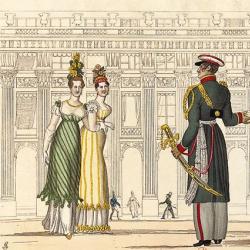Do-it-yourself dog costume and mask for an adult and a child: how to sew according to diagrams and patterns. We make a do-it-yourself Optimus Prime costume
By their dress code, costume parties (Halloween, etc.) require first-class costumes. In addition, competitions are usually held at such holidays for the best, most detailed superhero costume. Who would not be pleased to participate in such a competition in the costume of their favorite character?
I present to your attention an article on how do Optimus Prime costume their hands.
Necessary materials:

- Hot glue gun + sticks to it;
- Adhesive tape (red, gray);
- masking tape;
- Rulers of different sizes;
- Stationery knife;
- Scissors;
- Aerosol paints (primer, red, blue, white and silver);
- 4 mini flashlights;
- Helmet;
- Velcro;
- Cardboard or foam board;
- 2 empty tins;
- 2 plastic "visors" (for windshields);
- Hockey gloves;
- PVC pipes.
Step 1: Making the Head

Let's take a helmet or helmet as a basis. Cut out of cardboard (foamboard):
- Headphones (triangular pieces);
- Central block (rectangular piece);
- Side disks, on which it is planned to mount antennas in the future;
- Antennas.
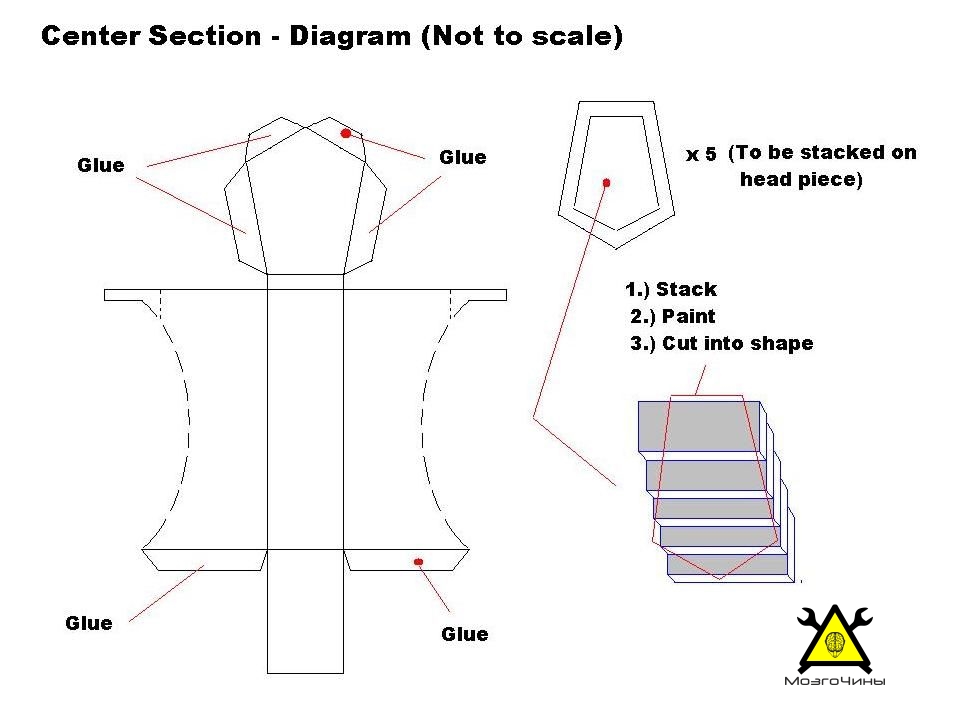
After everything is ready, it is necessary to cut recesses on the inside of the blanks. This is necessary in order to attach the "semi-finished products" to the helmet with hot glue.
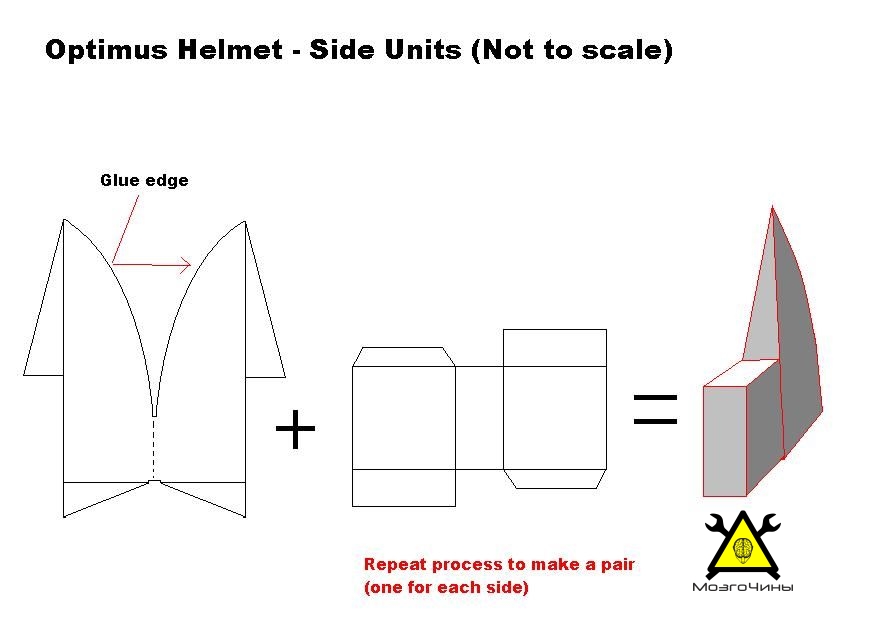
Cut the material in the central block should be gradual, so as not to remove excess.
We cut out 4 identical round disks, after which we fold the “inedible sandwich” from small pieces of cardboard and 2 disks. We glue them together, not forgetting to glue the ends of the resulting "sandwiches". While the glue dries, cut out 2 long strips (the length is equal to the length of the antenna). Let's cut grooves on the disks that will correspond to the size of the antennas. Then we apply some glue and put everything together.

Before painting, cover the exposed areas of the helmet with masking tape. We primed, and then we applied blue color to the surface of the headdress.
Step 2:

The lattice was made of foam board.
On the main A4 sheet, glue the side walls and the central partition. Mark and cut grooves of small depth (16 pcs). Carefully glue the strips adhering to the angle of inclination.
When painting foam board, it is not necessary to prime the surface.
Step 3: Chest
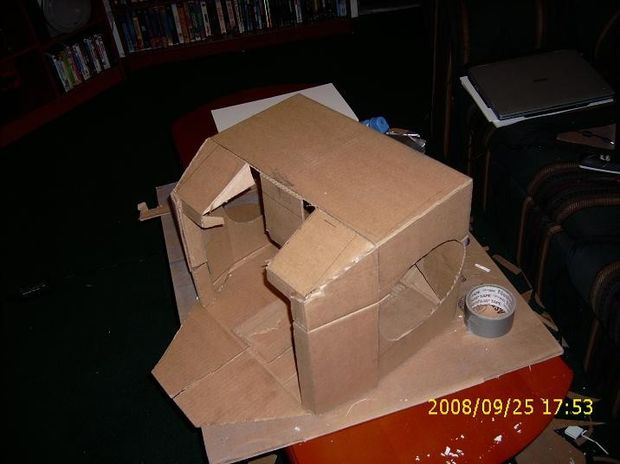
Take a box and cut out 2 large holes on the sides and try it on. If you feel uncomfortable, enlarge the holes.
We will make a vertical cut on the back to make it easy to put on and take off the suit.
Close the lid and cut out a large hole for the head. (The hole should be slightly larger than the head, so that the box itself does not rest on the neck).
Tape all inside curves with masking tape.
Step 4:
![]()
The opening on the back has an additional internal overlapping flap that will be used to secure the Velcro straps.
We fix the strips on hot glue. In addition, I strongly recommend flashing the fasteners with a wide seam (glue tends to tear off the top layer of cardboard).

Step 5: Coloring the Chest

Step 6:

After the paint on the sternum dries, glue the lanterns with hot glue.
We cut out two blanks from plastic according to the size of the “cabin windows” and paint them. Then we take two sheets of transparent plastic, cut them to size and glue them to the cabin.
If desired, window frames can be made from metal strips and fixed to the outer edges of the sternum.
Step 7: Putting the Torso Together

To increase the survivability of the suit, we will make the walls of the torso two-layered. Add a couple of braces to the inside to prevent slipping.
Step 8:

In order to make the feet, we need a pair of shoes and a rubber mat.
First, let's decide on the size of the feet. Let's make boxes by giving them the shape of a trapezoid.
Cut the rug into 8-12 pieces and glue them together with hot glue.

Leave a couple of layers in reserve to cover the top layer above the shoes.
Cut out a hole for the sneakers. Thanks to them, you will not slide forward or backward. Velcro will fix the shoes inside the foot.

Step 9: Making the Legs

Unfortunately, cardboard boxes are not made in the form of pyramids. Therefore, I had to remember the lessons of geometry and make them their hands.
Measure the length of the leg by adding about 12 cm above the knee.
Reinforce the inside curves with duct tape.

Double walls will make the structure stronger, but at the same time make it heavier.
Step 10:

Fasten the Velcro to the inside of the boxes.
Let's start making the front part of the lower leg, where the ventilation holes will be located.
Step 11:

Let's add entourage with the help of old wheels from a children's car.
For gas cylinders, old tin cans were used.
Step 12: New Helmet
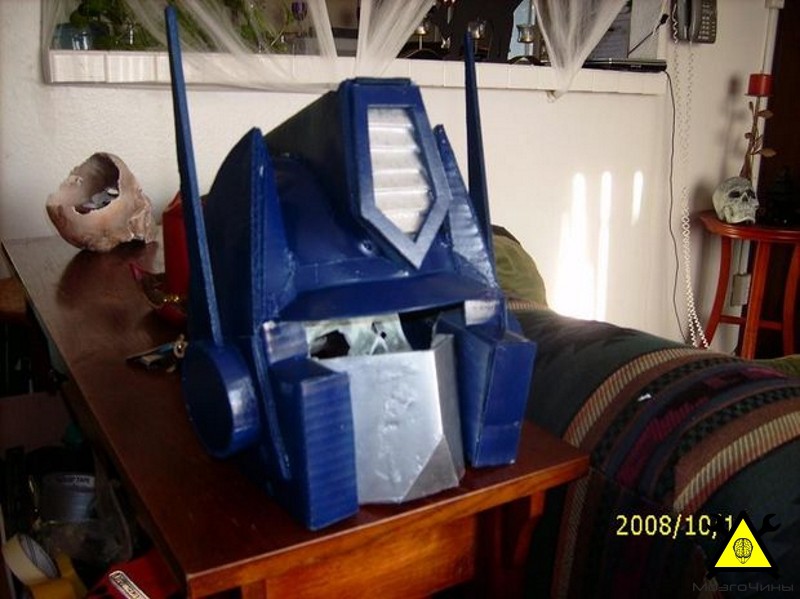
As it turned out, the old helmet was too heavy, hot and looked like a "melon" on top of the torso. Therefore, Prime needed a new headgear.
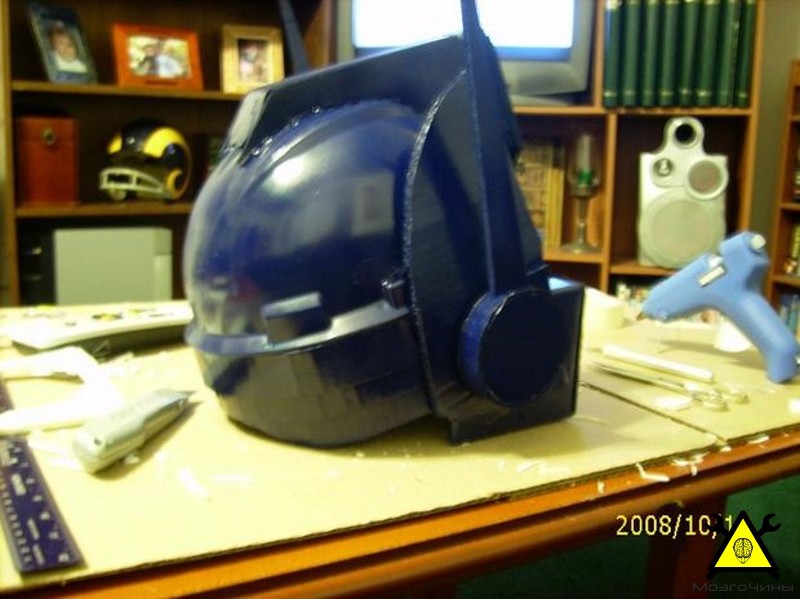
We will purchase a construction helmet and remove the belts from it. Instead, glue the lining from an old bicycle helmet.
Side flaps and antennae removed from an old helmet.
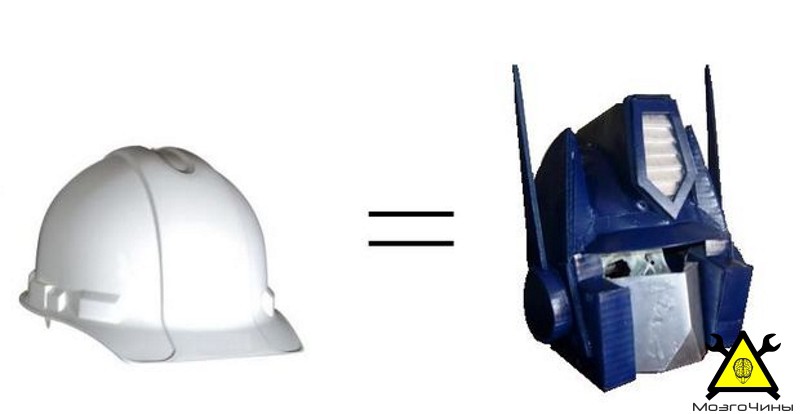
The face mask has been painted in colors that match other parts of the costume. It is removable and held in place by 2 small Velcro strips located on the inside.
Step 13: Almost done

After the finishing of the parts has been completed, we proceed to the fitting process (if necessary, we will cut off unnecessary parts and add adhesive tape for reinforcement).
You will need
- 2 packing boxes
- Foil
- colored paper
- piece of wire
- Universal glue
- tassel
- Scissors
- Pencil
- Ruler
- Scotch
Instruction
Attach antennas to your head. Pierce with an awl in the upper part of the head 2 holes at a distance of 3-4 cm from each other. Bend the wire so that you get 2 identical antennas and a gap between them equal to the distance between the holes. Insert wire. Tape it to the inside of the box. The holes on top can be covered with gray plasticine. Attach foam sponge tips to antenna antennae. Cut them out in shape, coat with glue and put on the wire.
Take the box meant for the torso. In the same way as on the "head", cut off the excess parts. You should end up with a tall cardboard box, also without a bottom edge. Mark and cut a round hole in the top edge. Find the center by drawing diagonals. The circle should be of such a size that the head passes freely, but at the same time it rests on the shoulders.
Cut holes for the hands. They can be made round by placing them closer to the top edge. But you can also make fairly wide slots, starting from the bottom of the side faces. Cover the body with foil. Before you decorate with different buttons and levers.
In principle, the costume is ready. But you can improve it by making more legs. To do this, you will need old sneakers, flip-flops or shoes without laces. You need shoes that you can put on freely and not suffer from lacing or clasps. Find two narrow and long boxes. As a rule such boxes are closed on a narrow and long edge. It needs to be glued, and both small sides should be cut off. Cover the box with foil. Sew shoes to the bottom of the "leg". And - forward to the carnival!
Do robot with their own hands - the dream of almost every teenager, and sometimes an adult who is fond of radio engineering. If you dream of a small homemade miracle, then go for it!
You will need
- old technique, constructor "Lego"
Instruction
Take as your basis small robot old technology. For a think tank robot You can use an old computer or laptop. With this method, through the already existing ports of the computer, we can use any programming language to control the robot and all kinds of devices that can be adapted to it.
Add a few LEDs to the circuit - and it will move in the direction of your hand or clearly along a light or dark strip. You can make it move forward when the refresh is directed directly at it, and stop when the light is turned off or attenuated.
Use phototransistors in the circuit - they are inexpensive and easy to use. With the reverse arrangement of the sensors, the robot will behave like a mole and hide from the light.
Liven up the behavior robot, by connecting the sensors to the plus of the power sources, then the robot will work in accordance with the light reflected by the LEDs. Excellent results are achieved with bright red or bright orange LEDs with a power of more than 1000 mCd.
For advancement robot along the black line of the white field, it must be at least 30 mm wide. When both photosensors capture the light reflected from the white field, the robot will have to move forward along the line. If at least one of the sensors crosses the black line, a rotation occurs. robot and position alignment. When the sensors illuminate the white field, the robot will move forward again.
Related videos
At first glance, the robot seems to be a complex creation, the creation of which requires a lot of knowledge, skills, time, effort and complex materials. However, in practice, the situation is quite different - to build robot it is quite possible independently at home, using the simplest materials in the construction process.

You will need
- Wheelbase, Nickel Cadmium or Lead Acid Battery, Receiver, Two Velcro, Adhesive, Servos, Dual-Lock Tape.
Instruction
Attach a nickel-cadmium or, if necessary, a lead-acid battery to the Velcro located on the bottom of the wheelbase. Attach the receiver to the top Velcro.
On opposite sides of the wheelbase close to the wheels, attach two servos with Dual-Lock tape.
Connect all components to the receiver with wires. To do this, first connect the battery to the channel marked "Batt", then connect two servos to the receiver. Make sure the servos are connected to adjacent but separate channels, not just one.
Related videos
note
An overly fragile wheelbase should not be used during operation. Otherwise, it may not withstand the load from the parts attached to it and break.
Useful advice
Before creating a robot project, it is necessary to determine the ultimate goals of the functioning of the mechanism. It is from this, ultimately, that its design decision and construction will depend.
Sources:
- Step-by-step instruction to create a robot from scratch. in 2017
Modern industrial robots are nothing like humans. Anthropomorphic robots today are used only as either toys or futuristic decorations. Making such a decoration is available to any home craftsman.

Instruction
As a torso for the robot, use the case from the old system unit, located sideways. Of all the components, leave only the power supply in the case. Make it permanently on by connecting the green wire to the common wire.
Make the legs of the robot from two pieces of plastic water pipes with a diameter of about 100 and a length of about 500 millimeters. Attach them to the bottom of the case with brackets. Attach a wide stand to their opposite ends with the same brackets. Make sure the structure is stable.
Make robot arms from pieces of plastic pipes of smaller diameter and length. Fasten them to the case on the sides also with brackets so that the power supply is not obstructed. Put boxing gloves on their opposite ends.
To simulate a head, glue a hollow cube from sheet plastic with a side of 200 to 300 millimeters. Make one of its walls removable. Fix the cube on the top wall of the case from the system unit, either directly or through a floppy box, which will imitate the square neck of the robot.
Stock up on bulbs rated for 6.3 V and 0.22 A. If you connect two of these bulbs in series and connect between the +5 V bus of the power supply and its common wire, each of them will have only 2.5 V. This is more than two times lower than the nominal value, so you won't have to change the bulbs for a very long time.
Be sure to make the robot's eyes out of two light bulbs. Distribute the rest over his head, torso, arms and legs as you wish. The main thing - do not allow short circuits and overload of the power supply.
Make the robot speak with a mechanical voice. Take an ordinary harmonica and speak through it the desired text in front of a computer microphone. Record the sound file in a player with a built-in speaker. Put the device inside the robot's head and start playback.
Related videos
Science fiction films usually depict humanoid robots, which are also called androids. But robots don't have to look like humans. Each of them has its own purpose. The robot, which you can make with your own hands, imitates the behavior of an animal. It is designed to play with children. Its prototype was Gray Walter's cybernetic turtle. Making such a homemade product will allow you to get rid of some unnecessary things.

You will need
- - photo exposure meter "Sverdlovsk-4" or similar;
- - plywood;
- - wheels from a chair or a mobile table;
- - switch or toggle switch for 2 groups of contacts;
- - parts from an old reel-to-reel tape recorder;
- - electric motors from a cassette recorder;
- - flexible multicore electrical wires;
- - relay RES-10 or similar for 1 switching group;
- - scissors for metal;
- - tin;
- - cambric;
- - paper clips (metal);
- - soldering iron;
- - soldering kit;
- - 2 flat batteries 4.5 V;
- - screws;
- - screws;
- - wooden bars;
- - plexiglass;
- - dried markers;
- - glue "Moment";
- - round elastic bands without braid;
- - wire with a cross section of 3 mm;
- - carpentry and locksmith tools.
Instruction
Disassemble 2 markers. Settle the content. Split the ends to make 2 plastic tubes. Connect the tubes together using a ring cut from the cap of the felt-tip pen. Secure the connection with Moment glue. With a file or knife, make a side hole at a distance of 2 cm from one of the ends. Hole diameter - 3 mm. Take 2 wires in different braids and thread them into the tube so that they go into the long end of the tube and go out into the side hole.
Carefully disassemble the photometer and unsolder the photodiode from it along with the reflector in which it is located. Be sure to remember the polarity. Solder the LED and solder the outputs of the relay control winding instead.
Solder a photodiode with a reflector to the wires coming out of the long end of the tube. Fix the reflector with Moment glue so that its axis is perpendicular to the tube. Carefully insulate the soldering points with cambric or electrical tape.
Connect the wires coming out of the side hole to the exposure meter board, observing the polarity. Connect a flat battery to the power contacts of the exposure meter. Use metal paper clips soldered to the wires as clips for contacts.
Opening and closing with the palm of the light stream to the LED and adjusting variable resistance located on the exposure meter board, the sensitivity of the resulting device, achieve a clear operation of the relay. If this does not work, replace the relay with a more sensitive one.
Cut out a 30x30 cm square from a sheet of plywood. At the corners adjacent to one of the sides, fasten 2 wheels from the chair. The wheels must rotate on their axles independently of each other, but always remain coaxial.
A drive wheel with a diameter of 10-15 cm can be made from a tape pulley of a suitable size, or cut out of plywood 3 mm thick. It has the shape of two round cheeks with a central insert. The insert should be 4-6 mm smaller in diameter than the cheeks.
Make a move and yaw block. Take a strip of plexiglass and bend it (for example, in hot water) it at a right angle so that one side is about 2 times longer than the other. The dimensions of the strip are arbitrary and depend on the dimensions of the parts. On the long end of the curved strip, fix the axle of the drive wheel-pulley, as well as one motor from the cassette recorder. Connect their pulleys with an elastic band so that the rotation of the engine pulley is transmitted to the drive wheel.
Make a strip of plywood or plexiglass and fix it on a square base so that the drive wheel bracket mounted on it allows the drive unit to rotate freely around vertical axis 45° left and right. This strip must be attached to the base by placing a wooden block of such thickness that the base itself, when placed on 3 wheels, is parallel to the floor. Using screws, connect this bar and bar. At the end of the bar, fix the drive block so that it rotates freely with minimal friction around the vertical axis. A thick bolt or screw can be used as an axis. Mount the photodiode tube vertically on the head unit. The photodiode should "look" in the direction of the robot's movement.
Make a yaw mechanism. Temporarily mount the second motor from the tape recorder on the base with the axis up. Attach a tin circle with a diameter of 5-6 cm or a flywheel from a cassette recorder to the axis. At a distance of 5 mm from the edge of the circle, make a hole with a diameter of 3 mm. Drill the same hole in the horizontal bar of the leading block. From steel wire with a diameter of 3 mm, make a U-shaped bracket. Insert the bent ends into the holes in the disc and drive block. Adjust motor position and clevis length so that one 360° turn of the wheel causes the drive unit to swing horizontally 45° to the left and right. Finally fix the engine.
The electrical circuit of the engine block is connected through a relay so that when the yaw mechanism is turned off, the lead block is turned on and vice versa. The electro-optical and electromechanical parts of the robot have separate circuits, each of which is powered by the same 4.5 V flat batteries, for which it is desirable to install a common toggle switch.
Children love New Year's reincarnations. It's so fun to try on someone else's image, play the role of your favorite character, copy his behavior. You can’t do without fantasy and imagination in a festive carnival, but you can’t do it without a good costume, no matter how hard you try. Without burdening yourself with unnecessary worries, you can take an outfit and a mask at the nearest box office. Striking out thereby the originality and unique incarnation. Can you sew carnival costume for the child independently according to the schemes and patterns, putting into the idea the unique features and features of the hero beloved by the child. Not an easy task, but final result a well-deserved reward for your hard work. Today we will help you implement it and teach you how to make a do-it-yourself dog costume and mask from fabric, paper, cardboard and other primitive materials. Role yellow dog especially relevant in the new year 2018.
Do-it-yourself dog carnival costume for a child: photo
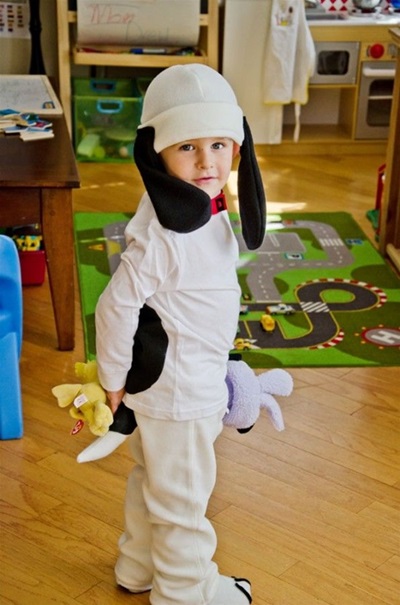
All variants of do-it-yourself dog carnival costumes for a child are conventionally divided into two categories:
- Expensive and complex costumes, involving the tailoring of a full-fledged full-length jumpsuit with a hood and all the distinctive features of the animal;
- Simplified sets made up of individual thematic details (fur ears, long tails, masks, gloves, paws, shaggy shorts / skirts / vests);
At the same time, the tailoring of the first version of the costumes will lend itself exclusively to skilled and experienced craftswomen who have a clear understanding of the basics of cutting and sewing. And any caring and intricate mother will cope with the second version of carnival outfits. So why create unnecessary difficulties for yourself? Prepare a do-it-yourself dog carnival costume for a child using our lightweight master classes with photos and videos.
Photo of do-it-yourself dog carnival costumes for a child

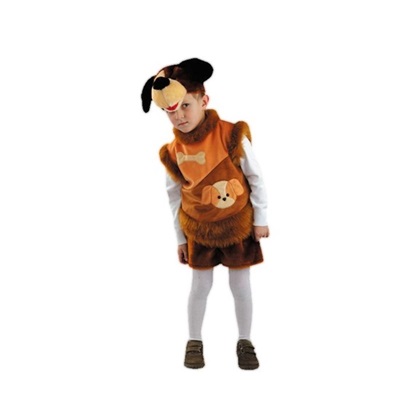







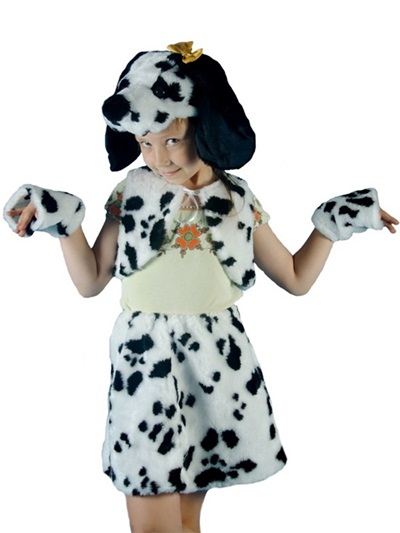
How to sew a do-it-yourself dog costume for a boy

The first master class on sewing a dog costume for a boy with his own hands is not at all costly, both in material terms and in time. The child himself will be able to make such an outfit, provided that all the materials are available. You don't even need your mother's help.
Necessary materials for a dog costume for a boy
- plastic hairband
- small piece of gray fleece
- thick cardboard
- gray thick yarn
- scissors
Step-by-step instructions on how to sew a do-it-yourself dog costume for a boy

Do-it-yourself dog costume for a girl according to diagrams and patterns

Not only boys, but also girls are not averse to trying on a dog costume made with their own hands according to patterns and patterns. After all, the next year 2018 will be held under the auspices of the Yellow Earth Dog, and any imitation of it is the key to success and luck in the future. But how to master a complex outfit without having on hand rolls of suitable fabric and boxes of the necessary accessories? Very simply, you can try to make a dog costume for a girl with your own hands according to diagrams and patterns, taking as a basis an old tracksuit from a home dressing room.
Necessary materials for a dog costume for a girl according to a simple scheme
- gray or white cotton suit
- black felt sheets
- needle and black thread
- pins
- scissors
- crayon or narrow bar of soap
- white Czechs
- black marker
Do-it-yourself step-by-step master class on a dog costume for a girl
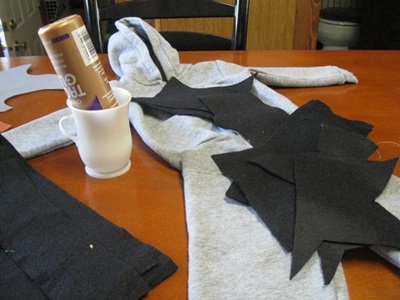
Do-it-yourself dog mask for a child or an adult from fabric, paper, cardboard: templates and patterns
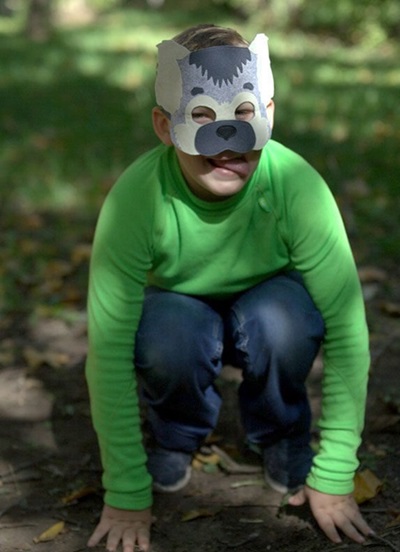
Dogs are loved by almost all children and most adults. These four-legged friends are a model of fidelity, justice, devotion and strong unconditional friendship. Dogs are excellent guards, brave defenders and good companions. This is probably why hundreds of children strive to try on their image at the New Year's masquerade in kindergarten and school. And also, from the fact that the Yellow Dog is a symbol of the next year, its unspoken patron. So, every mother should learn how to make a dog mask for a child or an adult with her own hands from fabric, paper, cardboard according to patterns and patterns.
Templates for dog masks made of cardboard and paper to create with your own hands for an adult and a child






![]()

A simple do-it-yourself dog mask made of paper and cardboard for a child on the head

Using the paper and cardboard templates above, you can quickly and easily make a beautiful dog mask on your child's head with your own hands. To do this, just print the image, strengthen it with cardboard, cut it out and assemble it in detail. For more detailed instructions on making a simple do-it-yourself dog mask out of paper and cardboard for a child's head, see the next master class.
Necessary materials for making a dog mask from cardboard and paper for a child
- printout of the mask from i-net
- thick cardboard
- scissors
- scotch
- satin ribbons
Step by step tutorial on how to make a simple paper and cardboard dog mask for kids

A complex do-it-yourself dog mask made of paper on a child's head

Today, not all children and teenagers can be surprised by a primitive flat mask with a picture of a puppy. Following the prescriptions of the current fashion and the desire to stand out among peers, the child can claim a more complex version of the 3D dog mask, and we will try to make it with our own hands from paper according to the most detailed video instructions. Some variants of such accessories are made from one or two solid parts, making many cuts and folding them according to the scheme. Other options are collected from dozens geometric shapes. See more details on how to make a complex paper dog mask on a child's head with your own hands in the step-by-step video tutorials.
Master class with video on making an intricate paper dog mask for a child
Do-it-yourself dog mask and costume made of paper, cardboard, fabric is always a joy for children and an extra hassle for adults. But not at this time! With our patterns, patterns and master classes, you will quickly understand how to make a mask and sew a carnival costume for a child in a matter of hours.

